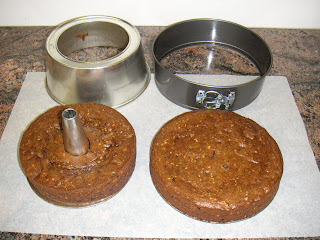





April is going out like a lion. Is there something amiss here? After our lovely "false" spring in south central Montana, we have been dealt a cold and windy week with temperatures in the 30s and low 40s and winds gusting up to 50 mph in some parts of the valley. The pink ground cover was in bloom before this cold snap--but it's tough and should make it.
Warming up the kitchen with something baking in the oven sounded like a good idea this morning with sleet coming down outside. I found a quart carton of Santa Barbara persimmons in the freezer from last fall and decided to do something with this delicious golden pulp.
Taking an idea from the classic apple sauce cakes of my youth, I substituted persimmon pulp with good success. I had enough ingredients on hand for two cakes--comparing cake flour with all purpose flour and using two different shapes of baking pans.
This recipe works well with apple sauce, of course, persimmons, and plums. In keeping with our determination to use local fruits (the persimmons were personally picked from our children's tropical yard in Santa Barbara, and packed and flown home in my suitcase last October. We let some ripen on the counter and ate them in hand. Delicious. The extras are peeled, crushed and frozen for holiday baking. Many families have pails full of plums in the summer, and apples in the fall that they are eager to share. Take advantage of it!
A tip on preparing the cake pans:
I love parchment paper and always use it to line cookie sheets and baking pans. Take one minute to line the pan bottom with parchment and you will pat yourself on the back over and over again. It makes cake removal a snap. No more sticking! And easy cleanup.
Place pan or tin on a piece of parchment paper and draw around it with a lead pencil. Cut out the shape and pop it in the pan. Lightly butter the non-papered sides. That's it. Some cookbooks insist on buttering the paper, too, but I have not found that necessary. For the tube pan, do the same, and then fold the circle of paper into quarters and snip out a circle to fit over the tube. Drop it in and lightly butter the sides of the pan.
Persimmon Pulp Spice Cake
Preheat oven to 350 F.
Variation for the 9" tube pan:
Beat until creamy in mixer:
1 stick butter (1/2 cup)
1 cup white (or brown) sugar
Add 1 large egg and mix well.
Sift 1 3/4 cups cake flour (see photo for tidy sifting tip) into a measuring cup set in a larger bowl which will catch overflow.
Add 1 tsp. baking soda, 1 tsp. cinnamon, 1/2 tsp. allspice (or nutmeg) to the flour and toss with a fork until the colored spices disappear. No need to sift again unless you want to.
Gradually add the flour and spices to the egg mixture. Just incorporate--don't over mix.
Add 1 generous cup fruit pulp
Add 1 cup raisins
Add 1 cup chopped walnuts (or other nuts)
Mix until just smooth. With aid of a rubber spatula, distribute evenly into tube pan.
Bake 50 minutes and test for done with a wooden skewer or thin blade table knife. Done when knife comes out clean. This is a robust cake and it can take up to 60 minutes, depending on ovens, etc.
When done, remove from oven and cool on the counter for a few minutes. If your pan has a removable tube, run a table knife around the sides (if necessary), and lift out the tube for faster cooling. If tube portion cannot be removed, leave cake in the pan until completely cool. If you try to turn it over and remove cake while warm, cake may break apart. When cool, peel off parchment paper. Cake may now be eaten as is, simply dusted with powdered sugar, or iced with your favorite frosting (lemon or caramel are good). This style of cake "packs" well--great for lunch boxes, backpacks, picnics, or mailing to lucky friends.
Variation for the single layer cake pan (a 9" spring form pan is pictured):
Same recipe as above, but used All Purpose flour. "Cake flour" was invented for the super sweet American-style box mixes popularized in the 1950s. For cakes with dried fruits (raisins), nuts, and other coarse ingredients, there is no difference in final result. Save your money! There are other drawback to cake flours (very low protein flours) that you can investigate online. Cake flours in the US are heavily bleached with chlorine dioxide or chlorine gas to improve certain chemical performance which I do not find necessary.
This variation used 1 tsp. ground ginger, 1/2 tsp. nutmeg, 1/4 tsp. finely ground black pepper instead of cinnamon and nutmeg which are more traditional and go well with apples. I enjoy a little more spice, hence the black pepper. We should try one with some chili pepper, too. Don't forget the baking soda.
The single layer bakes in slightly shorter time--50 minutes was plenty.
If using a spring form pan, release the lock and remove the side portion of the pan. Cool completely on the removable base. When cool, cover cake with a plate large enough to hold it, turn it over onto the plate and remove the pan base, and then carefully peel off the paper. Ready to serve or embellish with icings, etc.
Enjoy!
KGC






